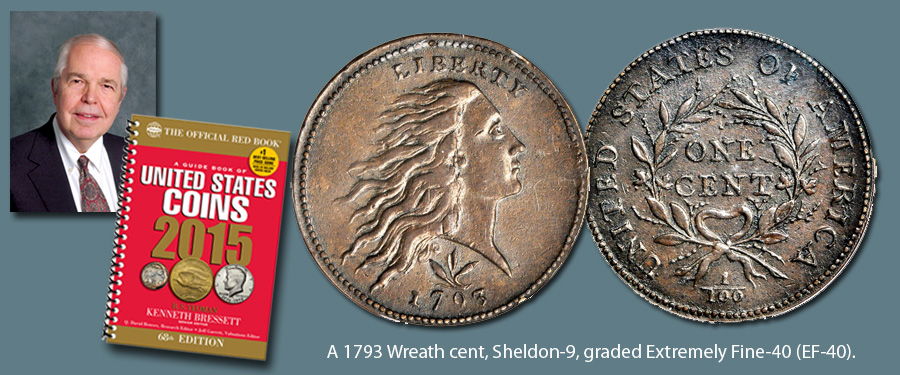
I continue my discussion of A Guide Book of United States Coins, the popular annual reference now in its 68th edition. The current volume bears a cover date of 2015, but was published last year in 2014. As you read these words the current edition is in press and is set to be launched in the spring. More than any other source, the Guide Book is the key for basic information on price, rarity and history of American coinage from colonial times to the present. It keeps growing, edition by edition, as more commemoratives and other issues are created, and as traditional series are expanded. The 2015 edition has 447 numbered pages. To read all the text would probably take several evenings, if time is taken to contemplate in a general way the coin listings and values. One nice thing about the Guide Book is its simplicity. For example, beginning on page 171 and continuing on 172, Barber quarters are listed by date, mintmark, mintage, and valuation in nine grades. This provides a quick overview for anyone to determine whether the series might be interesting to collect and what the costs involved are. At quick glance you can determine the extent of the series and the average cost of items. This is a good way to determine the practicality of collecting.
Returning to the early part of the Guide Book, page 9 is titled “Conditions of Coins.” This is a brief sketch, “essential elements of the American Numismatic Association Grading Standards,” the text says. The system ranges from perfection, Mint State 70, down to About Good 3. The first is described as: “Perfect new condition, showing no trace of wear. The finest quality possible, with no evidence of scratches, handling, or contact with other coins. Very few circulation-issue coins are ever found in this condition.” The lowest grade, AG-3, is defined: “Very heavily worn with portions of the lettering, date, and legend worn smooth. The ate may be barely readable.” Not mentioned in the Guide Book are two even lower grades, Fair-2 and Poor-1.
The 70-point system had its origin with Dr. William H. Sheldon who proposed it in Early American Cent, published in 1949. This was a market formula. Sheldon assigned a basal value to each of the large copper cent varieties minted from 1793 to 1814. His idea was that a basal value could be multiplied times the numerical grade to give the market value. For example, if an early cent had a basal value of $2 and it was in VF-30 condition, the market value would be $60. If it was in MS-60, the lowest level of Mint State the value would be $120. Today as you read these words this might seem curious, as for the past several decades there has been market emphasis on Mint State and mirror Proof coins, giving them many multiples over lower grades. In reality, the Sheldon system was flawed from the very start. Market values did not hold up when it was used, for example, in 1953 in Stack’s sale of the Anderson-Dupont Collection.
People like numbers. Numbers give a sense of security, it seems. Before the numerical system a coin would be described with adjectives, such as Good, Very Fine, Extremely Fine, Uncirculated (Mint State), or some other designation. A newcomer to the hobby would have no way of knowing if a Good coin was one that was especially nice or whether it was more or less desirable than Very Fine. With the grades in order, the system became easy to understand.
Dr. Sheldon intended the system to apply only to copper cents of 1793 to 1814, as noted. However, in time it spread to include colonial coins, then in the 1960s and 1970s collectors and dealers started using the system for all coins, including silver and gold. In the 1970s the American Numismatic Association decided to compile an official grading system, giving characteristics for each individual issue. Indian Head cents had different guidelines than double eagles, and both of these series were different from Barber silver coins. Kenneth Bressett, editor of the Guide Book and on the American Numismatic Association staff in Colorado Springs, supervised the project. Abe Kosoff, a prominent dealer from California, helped round up contributors to the system. Ideas were shared, tentative definitions were issued, and more. Finally, the book was ready. I wrote the introductory narrative to it. Since that time it has been published in several editions by Whitman. Intermediate grades not thought of by Dr. Sheldon were added, MS-63 being an example. Today, the grading information on page 9 of the Guide Book is just an overview. For complete information the Official ANA Grading Standards for United States Coins must be consulted. This is readily available from Whitman Publishing or from nearly every coin or hobby dealer.





